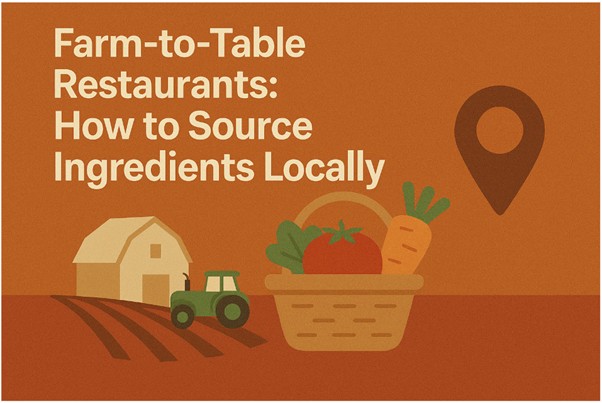
Farm-to-Table Restaurants: How to Source Ingredients Locally
As demand for fresh, ethical, and sustainable food grows, farm-to-table dining has evolved from a culinary trend into a commitment to community, health, and environmental responsibility. For modern restaurateurs, sourcing ingredients locally enhances flavour and quality and strengthens customer trust. According to renowned culinary expert Chef Shajahan M. Abdul, founder of Restro Consultants Pvt. Ltd. (RCPL), farm-to-table sourcing is one of the most impactful strategies for restaurants seeking authenticity, sustainability, and long-term customer loyalty.
But how can restaurants shift to sourcing locally, and what are the real benefits of going farm-to-table?
What Is Farm-to-Table?
Farm-to-table dining philosophy emphasises sourcing ingredients directly from local farms, growers, and artisans. It focuses on fresh, seasonal, and often organic produce while minimising food travel distance before reaching the customer’s plate. Restaurant consultants at Restro Consultants Pvt Ltd (RCPL) note that this model aligns perfectly with evolving consumer values around sustainability, traceability, and supporting the local economy.
Chef Abdul says, “Farm-to-table isn’t just a supply chain—it’s a story. And diners today want to know where their food comes from, who grows it, and how it’s made.”
Why Local Sourcing Matters
Restaurants that adopt a
farm-to-table approach enjoy several competitive advantages, as highlighted by
Chef Shajahan M Abdul and leading restaurant consultants at RCPL:
1. Fresher, More Flavorful Food
Locally sourced ingredients are
often harvested at peak ripeness and delivered promptly, preserving their nutrients
and flavour. This elevates the quality of every dish, creating a noticeable
difference that customers appreciate.
2. Supporting the Local Economy
By purchasing from local farms
and food producers, restaurants contribute directly to their communities’
financial well-being. According to RCPL, this generates substantial goodwill
and long-term brand loyalty among diners who value local impact.
3. Environmental Responsibility
Local sourcing reduces
transportation emissions and packaging waste. Chef Abdul notes, “The
farm-to-table approach dramatically lowers a restaurant’s carbon footprint,
making it one of the most environmentally conscious ways to operate.”
4. Menu Creativity and
Seasonality
Using local, seasonal produce enables
the creation of dynamic menus that adapt with the seasons, keeping offerings
fresh and exciting. Restaurant consultants find that seasonal menus create
anticipation and urgency among regular patrons.
How to Source Ingredients
Locally
Transitioning to a
farm-to-table model requires a strategic approach, effective networking, and
consistent execution. Here are the key steps recommended by Chef Shajahan M
Abdul and the experts at Restro Consultants Pvt Ltd (RCPL):
1. Build Relationships with
Local Farmers
Identify reputable farms,
dairies, fisheries, and cooperatives in your local area. Attend farmers’
markets, agricultural fairs, and food festivals to connect directly with
producers. Establishing trust and consistent communication is essential.
Chef Abdul advises, “Treat
farmers like partners. Chefs and growers collaborating leads to better products
and stronger supply chains.”
2. Source Through Local
Distributors or Food Hubs
Not every restaurant can manage
dozens of direct relationships. Local food hubs or cooperative distributors
consolidate produce from multiple farms, making it easier for restaurants to
source various items from a single location.
RCPL often helps restaurants
find and negotiate with such aggregators to streamline the sourcing process
without compromising quality.
3. Plan Menus Around
Availability
Local sourcing means you work
with what’s in season. Restaurants must remain flexible and design menus that
adapt to changes in ingredient availability. Consider “market-driven menus”
that change weekly or monthly.
“Let nature lead the menu,”
says Chef Shajahan M Abdul. “Seasonal ingredients force creativity and keep
customers returning for what’s new.”
4. Embrace Preservation
Techniques
Learning to preserve produce
through pickling, fermenting, freezing, or drying to make the most of seasonal
gluts. This helps maintain variety and consistency even when certain items go
out of season.
RCPL restaurant consultants
recommend creating a preservation plan aligned with seasonal calendars to minimise
waste and extend product availability.
5. Highlight Local Partners on
Your Menu
Transparency builds trust.
Mentioning the names of local farms or suppliers on your menu tells a
compelling story. It also supports cross-promotion, where farms feature your
restaurant in their marketing.
Chef Abdul notes, “Today’s
diners love a good backstory. Featuring your farmers adds value, credibility,
and emotional connection to each dish.”
Overcoming Challenges in Local
Sourcing
While the benefits are clear,
restaurants may encounter several challenges when adopting a local approach.
Here’s how to manage them:
1. Inconsistent Supply
Seasonal and small-batch
farming can lead to supply variability. Counter this by working with multiple
farms and building flexible menus.
2. Higher Costs
Local and organic products may
be pricier, especially for premium-quality ingredients. However, customers are
often willing to pay more for fresh and ethically sourced products. Restro
Consultants Pvt Ltd (RCPL) helps restaurants develop pricing strategies that
balance profitability and customer expectations.
3. Logistical Complexity
Managing multiple small
suppliers requires organisation. Restaurant consultants recommend integrating innovative
inventory systems and designating a sourcing coordinator to handle
relationships, orders, and deliveries efficiently.
The Future of Farm-to-Table
With climate change, consumer
consciousness, and supply chain instability all playing a significant role, the
farm-to-table movement is poised for expansion. Technology, such as digital
sourcing platforms and farm-to-chef networks, will make local sourcing even
more accessible in the future.
Chef Shajahan M Abdul believes,
“Farm-to-table will shift from being a niche to the norm. Restaurants that
embrace it now will lead the future of ethical and sustainable dining.”
Final Thoughts from Chef
Shajahan M Abdul
Farm-to-table sourcing isn’t
just a culinary statement—it’s a commitment to sustainability, transparency,
and community. It enables restaurants to serve superior-quality food, share
meaningful stories, and foster customer trust, leading to long-term success.
Chef Abdul says, “When you cook
with ingredients grown with care, you serve meals that matter. It’s not just
food—it’s connection.”
With expert support from Restro
Consultants Pvt Ltd (RCPL) and professional restaurant consultants, transitioning
to local sourcing can be both profitable and impactful, ensuring your
restaurant thrives, ethically and economically.
Chef Abdul © Copyright 2024. All rights reserved.